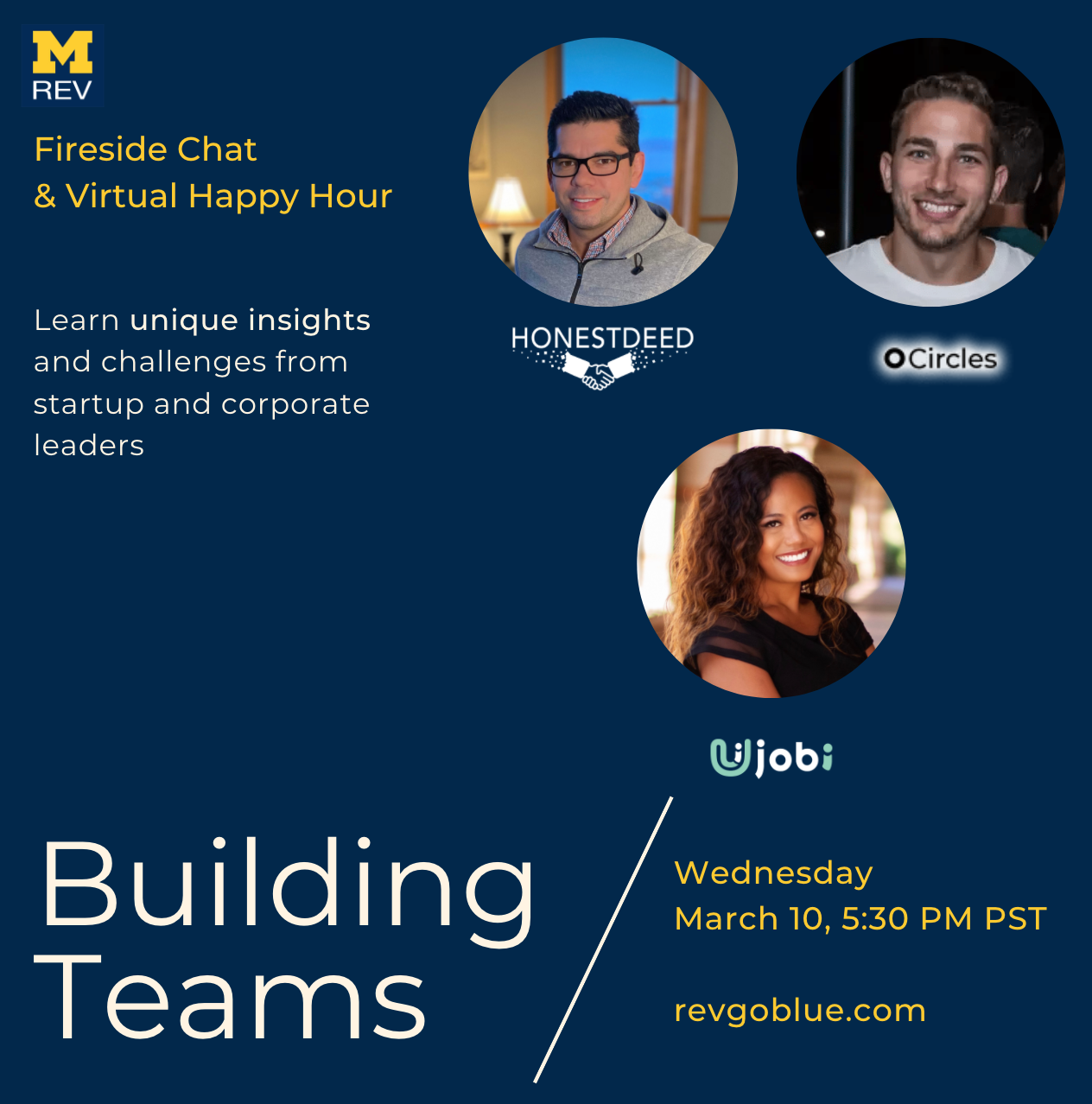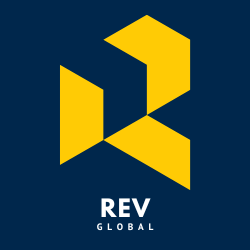
This March, REV hosted its first fireside chat of the year. We were joined by a panel of entrepreneurs and EMBA alums, and our topic is a perfect segue into part two and three of our Ideathon series.
The pandemic has heavily impacted the way enterprises and entrepreneurs build and retain their teams. Tonight’s panel will cover strategies and methods to overcome those barriers related to building distributed teams in this new remote-first environment.
Tammy Taw: Welcome everyone. Thank you for taking the time to join us. Let’s kick it off with introductions from our panelists, Raphael Bennet, Lynn Mulvihill, and Dave Schatz. Dave, let’s start with you first.
Dave Schatz: Thank you for including me in this. I worked with Lynn many years ago at Disney. After that I started a company called Noble Metrics out of New York. Did that for a couple years and then joined Facebook. I was at Facebook for about five years where I built and opened the New York engineering office and built the Ads API, or many parts of the Ads API with my team. I grew the office to about 500 people before I left. Obviously not alone, but with a team. Happy to share a lot of strategies we used then. After Facebook I started a company called Tape with my co-founder Tim. We recently sold that company and we’re building a new product called Circles. It’s a video communication, video collaboration tool built on top of Zoom. Excited to be here and share what learnings I have and hope it’s helpful.
Lynn Mulvihill: I’m a marketing exec at Disney during the day. And at night I’m the CEO of an early-stage startup called Ujobi, which is a marketplace and social impact startup that connects global talent with growing companies. So think Fiverr or TaskRabbit for students. We believe we have an untapped global workforce, particularly in emerging and developing countries, and our goal is to provide companies’ value, particularly in a time where the global economy is facing a lot of hardships. We want to help future generations get relevant experience and create a pipeline where they can have financial freedom, opportunity, and create the future they desire. I’m also joined by my team: Charlie, Cameron and Jess. I am a newer startup entrepreneur, and I have over 15 years of experience in the enterprise side at Disney, so really excited to share some of my insights to you as it relates to building teams.
Raphael Bennett: I’m an EMBA 25. I came out of the LA cohort. By trade, I’ve always been an entrepreneur, mostly on the technical side of most businesses, so I have a lot of experience building remote teams, managing them from a distance and building remote culture. I’m currently building a fintech startup. It’s basically a new way to finance homes without using what we would traditionally use: a mortgage. I’m about eight months into that process. I’ve got several team members that are here, Jared, Brian, Brandon, and Cameron. Looking forward to having a great conversation about building teams in this remote environment.
Tammy: Tonight we’re going to cover three themes. One around recruiting, and another around methodologies and tools to use to build a culture and lead the team, and then leadership. To kick us off in recruiting: what are the first steps of building a team? Let’s say you’ve validated your idea, the business model, you know that something’s there. Who’s your number two and number three, and how do you go about selecting those folks? Lynn, you want to go first?
Lynn: Yeah, I can definitely speak from a startup but also an enterprise and corporate perspective. I’ve been lucky enough to have this esteemed EMBA network and cohort and it really fell in place organically. Obviously, I’m very fortunate because I had people through REV and the EMBA program that displayed such a tremendous passion and always wanted to learn and grow.
I’m going to give a plug for REV’s Ideathon because, in many ways, if not for Ideathon last year, I don’t think much of our team would have coalesced and come together. I was telling people about the idea and validating it through Ideathon, and there was a group of doctors who had started something very similar.
When you start to have an idea, and you just honestly put it out there, there’s going to be a natural kind of attraction, people who will gravitate towards that idea, raise their hand, and display passion. In my case, this other group of entrepreneurs had started a very similar startup. There were natural synergies. I use the analogy of when you start dating and then you’re like, “Oh my gosh, they have all the same values and same interests”, and then it falls into place. From that, we were just thinking about all the people that we knew could be trusted and be fun people to work with. Between myself and Charlie, we recruited other folks to be part of the journey. That includes Jess, Tammy, Raph, a few folks in attendance here, to be advisors. It meant everyone was invested and committed to it. It’s still an early-stage startup, so we know that there are many other priorities, your full-time jobs, your other interests or other ideas and hobbies.
Through that organic formation, I was very lucky to be able to be in the company of my own network. That, coupled with this particular program, REV, and then Ideathon basically helped bring everything together.
My story is a little bit an exception, but I do think that’s the differentiator of the Michigan network. You’re going to find people who are passionate, committed, really smart individuals who just want to help. That’s definitely something that I find valuable. And honestly, I always tell people: if you’re coming up with idea, you want to build a team, just look in your backyard. Look at your business school classmates, look at your friends. And there’s going to be a natural, organic and authentic way that people are going to want to help and bring their expertise and skills to the table. That’s probably the best way to start that core team of leaders and people. You’re going to go through dark days and you’re going to want people who you can trust and call on and just vent to, to be honest.
Tammy: That makes total sense. Okay, let’s think about outside your network. Let’s say your network has been exhausted, they helped you in the past and there’s no one who can commit time. Dave, do you have any experience there?
Dave: Yeah. Just before jumping into that I just want to echo what Lynn said. I think tapping your networks is absolutely the best way to find talent. The best people we’ve ever worked with and continue to work with are folks that we’ve worked with in the past. We try to find folks we’ve worked with in other places, so folks I’ve worked with at Facebook, that Tim’s worked with at Amazon. What we like to do is make a list of the top five to ten people that we’ve ever worked with that would be dream coworkers. Whether they currently have jobs or they’re looking for something or not. And we reach out to them, we try to convince them to take a chance on us or see if they’re interested. You don’t know if you don’t ask.
I like to go through networks, because I’d rather have a referral to someone, especially for the early team, or referral to someone who had been vouched for, rather than going cold. And so, after I speak to folks, I’ll ask for names of who they recommend or who they’d ideally love to work with, and I’ll try and find it from there.
If I do have to go cold, so let’s say I’ve exhausted my network and I’m not finding anybody, and I know what the role is. For example, at Tape, we needed an absolute Android expert, and so I went on LinkedIn. I was scouring for people in the LA area (because we were co-located and we didn’t want to move someone out to LA at the time) at companies that we respected building quality Android apps shortlisted in LA. I would hit everyone up cold with a very personal message saying, “Hey, I would really love to grab coffee with you” or, “We’d love to have a small chat, we really respect the work that you’ve done, X, Y, Z.” And then really sell them really hard, talk about what our team does, and that’s how we were able to pull an Android engineer out of Snapchat to come join us. So I think cold outreach works if you’re, like Lynn said, authentic, and you help people realize different ways that they could get excited about the product that you’re building. And ways that what you’re doing aligns with either their interests or their values, because often times it does. Like Lynn said before, you want to work with people that are excited about what you’re building. If they’re not excited, they probably shouldn’t be part of the early team anyway. That wouldn’t be a good fit. Because you need everyone around the team to be excited so they can brainstorm together and share ideas and collaborate better.
Tammy: That’s a great point. Raph, I think you’ve mentioned this before in terms of time commitment: Obviously folks might not want to jump in too soon just because there’s their full-time job. What are your thoughts about how people split up their time? They’re excited about the idea, they know it’s promising, they just can’t quit their full-time job yet. What do you think about that?
Raphael: Yes. If you’re in the startup phase, you know it really depends how mature the company is, right? Early on, I feel that most people on your team should keep their actual full-time gig until you’ve all negotiated a real jump-off point. That’s where the company is mature enough and properly funded with enough runway to hold everyone for at least a certain period of time that you all agree on. But not every role early on in the business needs to be full time. You might just need some advisory stuff and there may be a couple of other team members that have more time and can contribute in those areas. I think you’ll find some founders and entrepreneurs are very strict about the type of commitment that they have to their startup. But in any business that I’ve ever had or any team that I’ve ever operated with, I always push them to try to find one other gig to keep their mind fresh. For example, something to consult on, to meet other people in their network, to push the narrative or the project that you’re actually working on, so that they can promote that in some way.
I’m a big fan of giving your team opportunity early on. Giving them the flexibility to consult, build their brand, and seek additional opportunity for personal and professional growth. As a leader, you want to make sure that you have enough maturity in the organization before you make commitments to people you can’t manage.
Tammy: Yeah, that makes a lot of sense.
Next up, we’re going to continue the conversation and discuss strategies and methods our panel uses to keep everyone working together toward the same goal.
